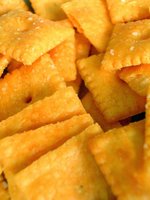
Yesterday, before we had the vegetable extravaganza, we had some lecture time on meats...stuff we didn't get to finish from last Wednesday's class. We talked about your primals, your sub-primals, your beef cuts, your pork cuts, your lamb cuts, and your veal cuts.
We also went over the receiving procedures for meat, plus some other tidbits about how meat is inspected, graded, etc. Government inspection of all meat in the United States is mandatory, and is inspected twice--on either the farm, ranch, or slaughterhouse (antemortem) and after butchering (postmortem). Inspection stamps are put on the primal cuts. The primal cuts are the main cuts of the animal. For example, the beef primals are chuck, ribs, loin, round, and brisket/plate/flank. Basically, it's the big cuts that are made during the first processing. The subprimals are the cuts and products that come from the primals, like the loin contains the tenderloin.
The quality grading of meat is a whole 'nother ball game. Quality grades, like prime and choice, are not mandatory. These grades are voluntarily sought out by the meat purveyor, i.e., the rancher, etc. You don't actually have to grade your meat, but you might be hard pressed to find someone to buy it without the grade.
When the meat is graded, the grader considers the following: the overall carcass shape, the ratio of fat to lean, the ratio of meat to bone, the coloring of the meat, and the marbleing of the lean meat. The quality grade given to a particular carcass is then applied to all cuts from that carcass. If your carcass is graded prime, then all the ribeyes, t-bones, etc. will be graded as prime.
You might also hear about the "cutability" of the carcass, which is a measure of the yield of edible meat from each pound of carcass. Very important, because you want to get the most bang for your buck.
The four USDA grades for beef are Prime, Choice, Select, and Standard. Choice and Select are what most of us see in the grocery store. Standard is probably what we all ate in the grade school cafeteria. Only 2% or so of the meat is actually graded as Prime, so that might explain why the ribeye at Ye Olde Expensive Steake House was so damme expensive. (Do you pronounce the "e" at the end of faux Old English words? I do because I think it's funny...in a pretentious-e sort-e of way-e.)
During this lecture, we all sitting facing the back of the kitchen where there are some posters thoughtfully provided by the National Association of Meat Purveyors (NAMP). These NAMP posters have an outline of the animal, with the primals shaded in, and then photographs of the actual meat part and the subprimal parts. If you look closely at the photos, you see that they are all numbered. The NAMP folks put out a guide that restaurants, wholesalers, etc. use to order meat, and it is standardized. For example, if you told your supply guy that you wanted a case of 1180s, you'd get a case of Boneless NY Strips. You might also want the 1180As, which are Center-Cut Boneless NY Strips. (These might not be the exact definitions of the numbers, but you get the drift.) It wouldn't matter if your supply guy (it's always "your guy" in Chef Speak) is in Oregon and you were in Opelika, Alabama, he's got the same numbers you do. It's essentially the Land's End Catalog of meat!
So, we're busy scribbling notes about our primal urges...cuts, and Chef Regional starts in with the "I want you to draw the carcass and label the primals" thing. Before I could stop myself, I blurted out, "You want us to DRAW a what?!" The man had just mentioned to us that we had collectively done less than stellar in his opinion on the sauce test (we've not seen our grades yet), and now he wants us to draw a cow? And a pig, a lamb, and a veal calf? I can't draw. I have a hard time fashioning a circle, much less the outline of a cow. I couldn't even properly trace those goofy "Draw Skippy the Turtle" ads in the back of my comic books. I'm thinking that I'm about to do even less than stellar on this test as well.
We finally get it sorted out that he wants us to do this for homework, and we can trace the outlines from the handy NAMP charts. Whew, big load off my carcass! ("Carcass"--get it!! hee hee hee!!)
Speaking of which, I guess I'd better haul my carcass into the dining room and finish my homework. I'll leave you with this parting thought: Last night, I had a dream that I was in a taxi cab, kinda like the Taxi Cab Confessions on HBO, with Alton Brown and Mos Def, and we were hurtling along the streets of NYC, eating Cheez-Its and looking for Mario Batali's restaurant. And, when I woke up from this dream, the first thing I thought of was I wonder how Mos Def knows Alton.

I have so got to stop eating Cheez-Its before bed.
And, The Man has returneth from the wilds of his home state. His granddad is doing better, and the poodles and I are glad to have him back. Although, this means they have to give up sprawling with abandon on his side of the bed.

3 comments:
Love the Stones reference!
The only thing I know about cutting meat I learned from my dad while butchering moose and caribou. Wow, that makes me sound like a hick!
The Land's End of Meat sounds interesting, though. And, one of my favorite bands is called the Meat Purveyors. I didn't realize it was an actual term for an actual group of people who sell meat. Silly me!
I always found meat cuts interesting, I don't have a clue why. We have been to butcher houses a couple times, some smelled okay and others would make you gag.
So--What ARE your favorite cuts? For me, with beef and pork, I gotta admit it's all about tenderloin. My favorite thing I ever cooked in my whole entire life was a roast tenderloin of beef, in a roasted-shallot/rosemary gravy. I don't think I ever made anything before or since that tasted so good. But the meal, for two, cost like $70 all told for ingredients. So. It's not something we have weekly.
Post a Comment